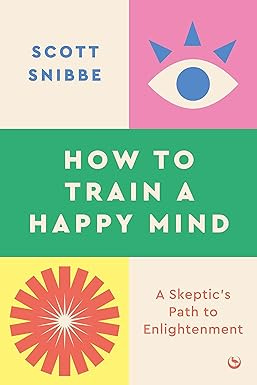Book Freak is free, but if you like it, please consider becoming a paid subscriber.
I’ve always thought meditation was about trying not to think about anything. But I learned in Scott Snibbe’s book, How to Train a Happy Mind: A Skeptic's Path to Enlightenment, there are two kinds of meditation. There’s stabilizing mediation, which “calms the mind,” and there’s analytical meditation, which “changes the mind.”
Here’s how Snibbe describes analytical meditation:
This form of meditation goes beyond watching your mind to actively steer it away from disturbing thoughts, like anxiety, fear, and craving; and toward beneficial ones, like satisfaction, joy, and generosity. Instead of calmly watching whatever comes into your mind like you do in stabilizing meditation, in analytical meditation you actively question what pops into your mind, and proactively cultivate beneficial thoughts and feelings that steer it toward openness, happiness, and compassion.
Snibbe's book presents a structured program of analytical meditations adapted from a 1000-year-old Buddhist sequence called the lamrim. Although inspired by Buddhist ideas (Snibbe is a Buddhist himself), it does not require any religious beliefs and is grounded in what modern science reveals about the mind and reality.
The meditations in the book are a fascinating way to explore my mind and learn how it works (and sometimes how it fails to work). I find it more enjoyable and interesting than passive meditation. (However, Snibbe emphasizes the importance of beginning an analytical meditation session with a few minutes of stabilizing meditation to clear the mind, and I have found this advice to be crucial.)
One meditation exercise from the book that I could do every day without getting bored is about exploring the "space of your mind." After achieving a state of relaxation, you examine your consciousness as if it were a physical space:
Is the space of your consciousness dim or bright? Is it clear or obstructed? Does it stay the same or does it change?… Now watch how objects appear within the space of your mind. The signals from your eyes, ears, imagination, and memory transform into forms, sounds, and other perceptions that take shape in your awareness. Whatever texture and color the mind has gets sculpted into the form of what you perceive. See how these mental objects rise and fall within your consciousness. You can bring each appearance closer to examine it or let it fade away.
In some ways, How to Train a Happy Mind reminds me of another favorite book, Astonish Yourself: 101 Experiments in the Philosophy of Everyday Life.
Unclassifieds
Buy a Book Freak Unclassified ad for $50 and reach over 12,500 readers!
Listen to Articles as Podcasts. Email us a link, and our AI will deliver human-like narration directly to your podcast app. Try for Free.
I use a fantastic app called Reader, the first read-it-later / newsletter / RSS-reading / web-highlighting app for power readers. Save everything to one place, highlight like a pro, and replace several apps with Reader. Book Freak readers can try it free for 60 days.
The Magnet is Book Freak editor Mark Frauenfelder’s newsletter of curiosities across space and time. Subscribe here.
Setapp is a hand-picked collection of quality software, packed with prime apps. There’s no store — just a folder on the Mac, and no hidden costs — just a flat monthly fee. It’s simple, and users love it. Try it here!
Book Freak is published by Cool Tools Lab, a small company of three people. We run the Cool Tools website, a video reviews YouTube channel, and other newsletters, including Gar’s Tips & Tools, What’s in my NOW?, and Recomendo. You can also support our work by becoming a patron via Patreon.



